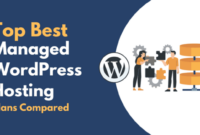WordPress shared hosting services set the stage for this enthralling narrative, offering readers a glimpse into a story that is rich in detail and brimming with originality from the outset. Dive into the world of WordPress shared hosting with us.
In this comprehensive guide, we will explore the ins and outs of WordPress shared hosting services, covering everything from setup to optimization and security measures.
Introduction to WordPress Shared Hosting Services

WordPress shared hosting services are a type of hosting where multiple websites share the same server resources. This differs from other hosting options like dedicated hosting, where a single website has exclusive access to server resources.
Are you new to the world of web hosting? Don’t worry, there are plenty of options available for beginners. Web hosting for beginners offers user-friendly interfaces and helpful support to guide you through the process of setting up your first website.
Benefits of Using Shared Hosting for WordPress Websites
- Cost-Effective: Shared hosting is more affordable as the server resources are split among multiple websites, reducing individual costs.
- User-Friendly: Many shared hosting providers offer easy-to-use interfaces and one-click WordPress installation, making it ideal for beginners.
- Technical Support: Shared hosting services often come with customer support to assist with any technical issues or questions.
- Scalability: Shared hosting allows for easy scalability, making it simple to upgrade your resources as your website grows.
Popular Companies Offering WordPress Shared Hosting Services
- Bluehost: Known for its WordPress optimization and reliable services, Bluehost is a popular choice for shared hosting.
- SiteGround: SiteGround offers fast and secure hosting with excellent customer support, making it a top choice for WordPress users.
- HostGator: With affordable pricing and user-friendly features, HostGator is a well-known option for WordPress shared hosting.
Features to consider when choosing WordPress shared hosting

When selecting a WordPress shared hosting plan, there are several key features to consider to ensure that you are getting the best value for your website. From performance to security and customer support, each aspect plays a crucial role in the overall success of your hosting experience.
Essential Features to Look for in a WordPress Shared Hosting Plan
- WordPress Optimization: Look for hosting providers that offer specialized WordPress optimization to ensure your website runs smoothly and efficiently on their servers.
- Uptime Guarantee: Choose a hosting provider that guarantees a high uptime percentage to ensure your website is accessible to visitors at all times.
- Scalability: Opt for a hosting plan that allows for easy scalability as your website grows, offering the flexibility to upgrade resources as needed.
- Automatic Backups: Ensure that the hosting plan includes regular automatic backups of your website data to prevent any loss of information in case of emergencies.
Comparing Pricing Structures and Packages
- Shared Hosting Plans: Compare the pricing of shared hosting plans across different providers to find the best balance between cost and features offered.
- Renewal Rates: Pay attention to the renewal rates of hosting plans, as introductory prices may increase significantly after the initial term.
- Additional Services: Consider the value of additional services such as free domain registration, SSL certificates, or email accounts included in the hosting package.
Importance of Performance, Security, and Customer Support
- Performance: Choose a hosting provider that offers fast loading speeds and reliable server performance to provide a seamless user experience for your website visitors.
- Security: Prioritize hosting providers that implement robust security measures, such as malware scanning, firewalls, and SSL certificates, to protect your website from cyber threats.
- Customer Support: Select a hosting provider with responsive customer support available 24/7 to assist you with any technical issues or questions that may arise.
Setting up a WordPress site on shared hosting
When setting up a WordPress site on shared hosting, it’s essential to follow a step-by-step process to ensure a smooth installation and configuration. In this guide, we will walk you through the process of installing WordPress on a shared hosting environment and explain how to manage domains, databases, and files within your hosting account.
Installing WordPress on Shared Hosting
- Access your hosting control panel: Log in to your hosting account and locate the control panel, often referred to as cPanel.
- Find the “Auto Installer” section: Look for options like Softaculous or Fantastico, which are popular auto-installers for WordPress.
- Select WordPress for installation: Click on the WordPress icon and follow the on-screen instructions to complete the installation process.
- Create an admin account: Set up your admin username and password, along with other site details during the installation.
- Access your WordPress site: Once the installation is complete, you can access your WordPress site by entering your domain name in a web browser.
Managing Domains, Databases, and Files
- Domain management: In your hosting account, you can add new domains, set up subdomains, and manage domain settings through the control panel.
- Database management: Use tools like phpMyAdmin to create and manage MySQL databases for your WordPress site.
- File management: Utilize the File Manager in cPanel to upload, edit, and organize files for your WordPress site.
Common Issues and Troubleshooting
- Internal Server Error: Check file permissions and PHP memory limit settings.
- White Screen of Death: Disable plugins or switch to a default theme to identify the issue.
- Database Connection Errors: Verify database credentials in the wp-config.php file.
- File Upload Issues: Adjust file upload limits in the php.ini file or contact your hosting provider for assistance.
Optimizing WordPress performance on shared hosting: WordPress Shared Hosting Services
When it comes to optimizing the performance of a WordPress site on shared hosting, there are several key strategies to consider. By implementing these tips, you can enhance the speed and overall performance of your website, even in a shared hosting environment.
Utilize caching plugins
Caching plugins are essential tools for improving website performance on shared hosting. By caching static content and reducing the need to generate the same content repeatedly, caching plugins can significantly speed up your site. Popular options include WP Super Cache, W3 Total Cache, and WP Rocket.
For those who prefer a hands-off approach to hosting, a managed hosting provider like Managed hosting provider can be a great choice. These companies take care of all the technical aspects of hosting, allowing you to focus on your business without worrying about server maintenance.
Implement a content delivery network (CDN)
A content delivery network (CDN) helps distribute your website’s static content across multiple servers worldwide, reducing latency and improving load times for users. By using a CDN, you can deliver content more efficiently and enhance the overall performance of your WordPress site.
Optimize images and files
Optimizing images and files can also have a significant impact on your website’s performance. By compressing images, minifying CSS and JavaScript files, and reducing the size of your website files, you can improve load times and overall speed.
Monitor and optimize performance
Regularly monitoring the performance of your WordPress site is crucial for identifying potential issues and areas for improvement. Utilize tools like Google PageSpeed Insights, GTmetrix, or Pingdom to analyze performance metrics and make necessary optimizations to enhance speed and user experience.
When looking for the best hosting company in 2024, it’s important to consider factors such as uptime, customer support, and pricing. One top contender for this title is Best hosting company 2024 , known for its reliable services and excellent customer satisfaction rates.
Security measures for WordPress sites on shared hosting
When it comes to WordPress sites on shared hosting, security is a top priority. Shared hosting environments can pose unique security risks, so it’s essential to implement the right measures to protect your website.
Common security risks associated with WordPress shared hosting
Shared hosting environments can be more vulnerable to security threats due to the multiple websites hosted on the same server. Some common security risks associated with WordPress sites on shared hosting include:
- Potential for cross-site contamination
- Increased risk of malware infections
- Weaker server-level security
- Higher likelihood of DDoS attacks
Checklist of essential security measures
To protect your WordPress site on shared hosting, consider implementing the following essential security measures:
- Keep WordPress, themes, and plugins up to date
- Regularly backup your site and database
- Use strong passwords and consider two-factor authentication
- Limit login attempts and implement login lockdown
- Install security plugins like Wordfence or Sucuri
Importance of regular updates, backups, and security plugins
Regular updates, backups, and security plugins play a crucial role in maintaining a secure WordPress site on shared hosting. Updates help patch vulnerabilities, backups ensure you can restore your site in case of a breach, and security plugins add an extra layer of protection against threats.
Scaling and Upgrading WordPress Shared Hosting

When managing a WordPress site on shared hosting, there may come a time when the site outgrows the resources provided by the shared server. In such cases, upgrading to a VPS (Virtual Private Server) or a dedicated server becomes necessary to ensure optimal performance and scalability.
When to Consider Upgrading, WordPress shared hosting services
- When the site experiences frequent downtime due to high traffic volume
- If the site requires more storage space or bandwidth than what shared hosting offers
- When additional security measures are needed to protect sensitive data
Migrating to a Higher-Tier Hosting Solution
- Back up all WordPress files, databases, and settings before proceeding with the migration
- Choose a reputable VPS or dedicated server provider and select a hosting plan that meets the site’s requirements
- Transfer the WordPress site by uploading files, importing databases, and configuring settings on the new server
- Update domain DNS settings to point to the new server to complete the migration process
Scaling Resources and Handling Increased Traffic
- Monitor site performance regularly to identify bottlenecks and resource limitations
- Optimize WordPress plugins, themes, and scripts to improve site speed and efficiency
- Implement caching solutions and content delivery networks (CDNs) to reduce server load and accelerate content delivery
- Consider load balancing and clustering techniques to distribute traffic across multiple servers for better scalability
As we come to the end of this guide, you now have a solid understanding of WordPress shared hosting services and how to make the most of them for your website. Implement these strategies and watch your site thrive in the competitive online landscape.



